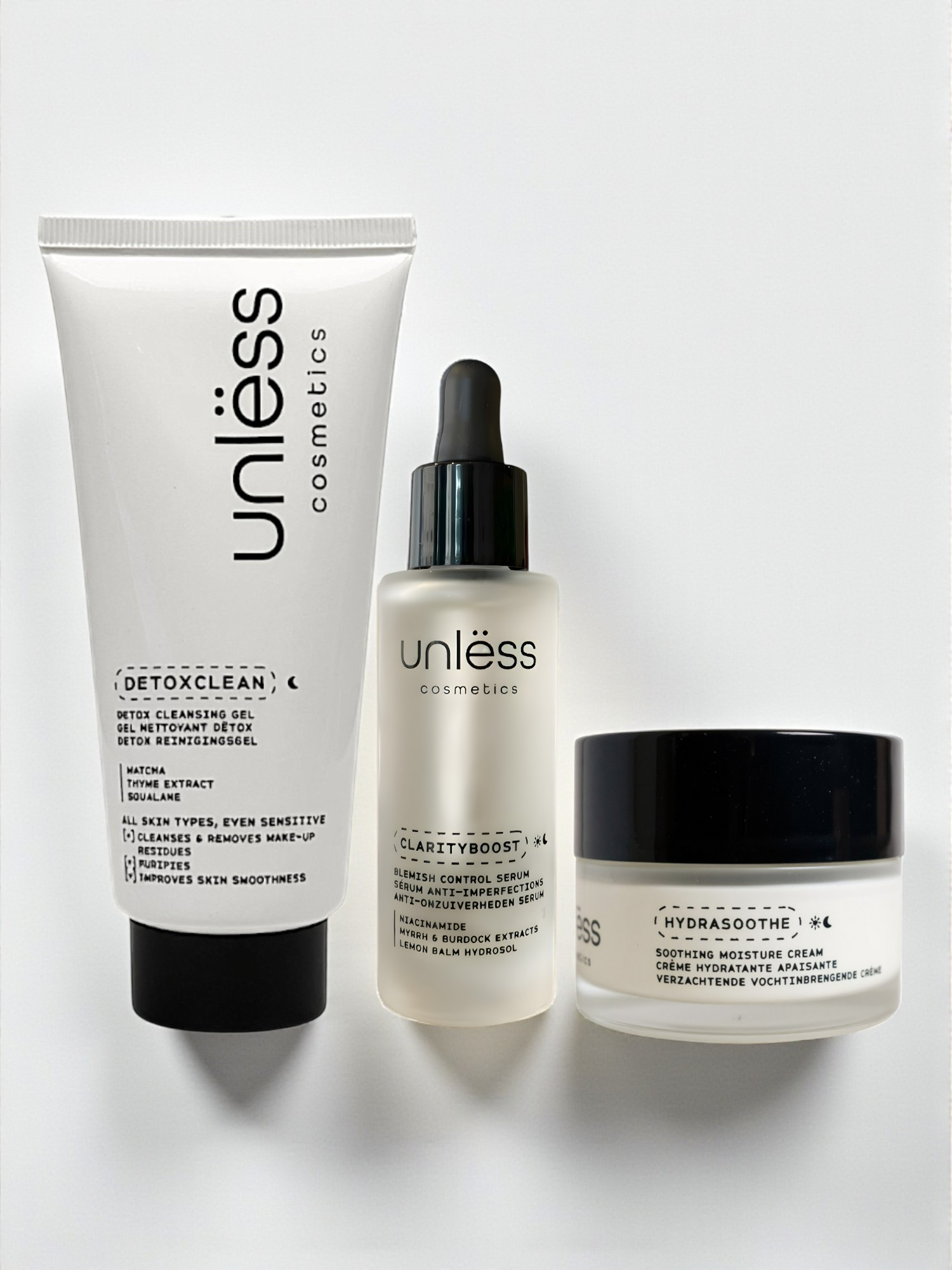The ban list.
"THIS LIST IS OUR STATEMENT OF INDEPENDENCE AGAINST COMPROMISE. IT AFFIRMS OUR COMMITMENT TO OFFERING YOU THE BEST, WITHOUT CONCESSIONS."
- The founders


Notre engagement pour des soins sans compromis ni ingrédients controversés
At Unlëss Cosmetics, we strongly believe in the transparency and safety of the products we offer.
That’s why we’ve established a list of ingredients that we commit to never using in our formulations. These substances, often controversial or associated with unethical practices, can be potentially irritating, allergenic, or harmful to the skin and overall health.
By choosing our products, you are choosing transparent beauty, respectful of your body and the planet.
Find out why these ingredients are excluded from our products.
List of prohibited ingredients
Ethyl alcohol
Ethyl alcohol, often used in cosmetics as a preservative or solvent, can be irritating to the skin, leading to increased dryness and sensitivity, especially when present in high concentrations. Its excessive use can disrupt the skin's natural protective barrier, potentially leading to irritation and allergic reactions.
INCI: Alcohol
BHT/BHA
BHT (butylated hydroxytoluene) and BHA (butylated hydroxyanisole) are antioxidant agents used in cosmetics to extend the shelf life of products. However, they have been associated with concerns about their potential for endocrine disruption and impact on human health. Additionally, these compounds have been studied for possible carcinogenic effects, raising concerns about their prolonged use.
INCI: BHT, BHA
Chlorphenesin
Chlorphenesin is a preservative derived from chlorine that is used in cosmetics to prevent bacterial and fungal growth. In addition to being an irritant, its manufacturing process is very polluting.
INCI: Chlorphenesin
Artificial colors
Synthetic dyes have been associated with allergic skin reactions, irritations and increased sensitivities.
INCI: CI xxxxx
Ethoxylated and propoxylated compounds
Ethoxylated and propoxylated compounds are commonly used ingredients in cosmetics as emulsifiers, surfactants or texturizing agents. They pose a risk to the environment and some are suspected of being carcinogenic.
INCI: Polyethylene Glycol (PEG), Propylene Glycol (PPG), Sodium Laureth Sulfate, Hydroxyethylcellulose, etc.
EDTA
EDTA (ethylenediaminetetraacetic acid) is an agent used in cosmetics to improve the stability of formulas. Environmental concerns have been raised regarding its biodegradability and persistence in the environment.
INCI: EDTA
Essential oils
Essential oils, despite their natural origin, can cause severe irritation or even burns to the skin and mucous membranes. They can also trigger allergic reactions or increased sensitivity to the sun.
Mineral oils
Derived from heavy and highly polluting petroleum refining, mineral oils are occlusive in nature and can clog pores, leading to irritation, breakouts or acne problems. In addition, their prolonged use is suspected to be carcinogenic. They can also disrupt the skin's natural balance and create a dependency on external moisture, compromising the skin's natural ability to regulate its own moisture levels.
INCI: Paraffinum Liquidum, Petrolatum, Paraffin, Synthetic Wax, Cera Microcrystallina etc.
Formaldehyde releasers
Often used as antimicrobial preservatives, formaldehyde releasers gradually break down to release small amounts of formaldehyde, a suspected allergen and carcinogen.
INCI: DMDM Hydantoin, Diazolidinyl Urea, Imidazolidinyl Urea, Methenamine, etc.
MIT/MCIT
The preservatives MIT (methylisothiazolinone) and MCIT (methylchloroisothiazolinone) are known to cause skin irritation, allergic reactions and sensitivities in some individuals.
INCI: Methylisothiazolinone, Methylchloroisothiazolinone
Isopropyl myristate
This ingredient is sometimes associated with adverse skin reactions, such as irritation and clogged pores, which can lead to acne or other skin problems.
INCI: Isopropyl Myristate
Nanomaterials
These very small particles (1-100 mm) raise concerns about their deep penetration into the body and their impact on long-term health.
INCI: Zinc Oxide (NANO), Titanium Dioxide (NANO), etc.
Parabens
Although widely used as preservatives to extend the shelf life of products, parabens raise serious concerns due to their potential for hormone disruption.
INCI: Butylparaben, Ethylparaben, Methylparaben, Propylparaben, etc.
Perfumes
Fragrances, whether natural or synthetic, can irritate facial skin and cause allergic reactions or sensitivities, compromising the comfort and health of your skin.
INCI: Perfume
Proven and suspected endocrine disruptors
More generally and within the limits of scientific knowledge at the time of developing our formulas, we exclude all proven or suspected endocrine disruptors from the composition of our products.
Phenoxyethanol
Phenoxyethanol is a preservative known for its strong allergenic and irritant power. It is also suspected of having toxic effects on the blood and liver and of being an endocrine disruptor.
INCI: Phenoxyethanol
Phthalates
Fixing and plasticizing agents, they are suspected of being endocrine disruptors.
INCI: Phthalate
Silicones
Although they are not dangerous to human health, silicones are very poorly biodegradable and pollute the environment.
INCI: Dimethicone, Cyclomethicone, Cyclopentasiloxane, Polysiloxane, etc.
Sulfates
Sulfates are criticized for their high propensity to irritate the skin and alter skin lipids, thereby disrupting the formation of the skin's protective hydrolipidic film.
INCI: Sodium Lauryl Sulfate, Sodium Laureth Sulfate (SLS), Ammonia (Laureth) Sulphate, etc.
Triclosan/Triclocarban
As preservatives, they are suspected of being endocrine disruptors in addition to being harmful to the environment.
INCI: Triclosan, Triclocarban



